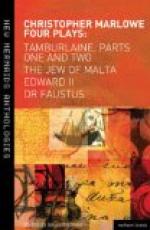|
This section contains 837 words (approx. 3 pages at 300 words per page) |

|
Tamburlaine and Tragic Heroism
In his two plays, Tamburlaine the Great, Parts I and II, Marlowe deviates from the norms of the theory of tragedy in his depiction of Tamburlaine. According to the Aristotelian theory of tragedy, a tragic hero is of a noble origin and enjoys a great rank right from the very beginning of the play. Furthermore, a tragic hero is, in a simple sense, a man likeable for his goodness or greatness. A tragic hero, in addition, is doomed to make a serious error that will cause his downfall and tragic death finally evoking pity and fear in the audience. In fact, Tamburlaine's character noticeably violates these three elements of the model tragic hero.
Firstly, Tamburlaine is ironically of a base birth. In fact he is a Scythian shepherd by birth and does not enjoy any noble rank in his environment. The irony is underlined...
|
This section contains 837 words (approx. 3 pages at 300 words per page) |

|


